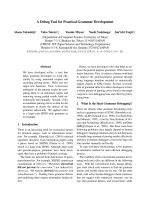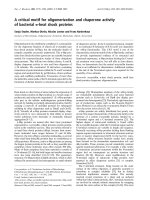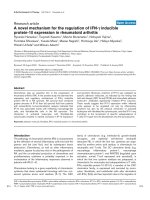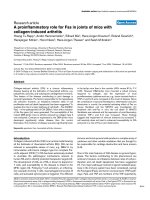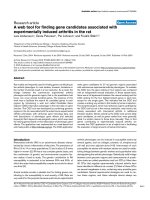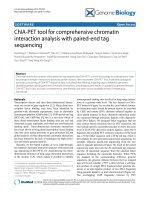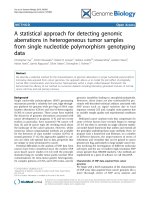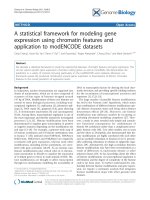Báo cáo y học: "A useful tool for trainees in intensive care" pps
Bạn đang xem bản rút gọn của tài liệu. Xem và tải ngay bản đầy đủ của tài liệu tại đây (77.75 KB, 1 trang )
1
Available online />This manual is already in its 5th edition. This 1200-page
intensive care manual covers most of the field of intensive
care practice, including organizational aspects and pediatric
intensive care. Most of the contributors originate from
Australia, the UK, and Hong Kong, and have a large
experience in clinical practice, research, and teaching in
intensive care. This manual lies somewhere between a
handbook and a textbook, with the size of a textbook and the
practical presentation and conciseness of a handbook. This
format is somewhat regrettable because on the one hand the
book is clearly too large to be stored in the pocket but on the
other hand it is not exhaustive either. Given the information
presented, this book is clearly intended for physicians in
training in intensive care; a more experienced audience
would rather read a more in-depth intensive care medicine
textbook. The principal merit of the book is that young
physicians can rapidly find up-to-date practical information.
The book covers most aspects of intensive care practice,
including a rapid description of the diseases that may be
encountered in critically ill patients, the specifics of critically ill
patients, and the therapeutic interventions and monitoring
techniques that may be used. The quality of the different
sections is quite heterogeneous. For example, the
cardiovascular section covers the various etiologies and
therapies of shock, hemodynamic monitoring, and multiple
organ dysfunction. The chapter on hemodynamic monitoring is
really outstanding. The information presented is not limited to
the pulmonary artery catheter but also covers all the newer
technologies. Transpulmonary thermodilution and its derived
volumetric indices are discussed, as well as lithium dilution,
esophageal Doppler and echocardiography. The limitations
and advantages of each of these techniques are discussed
and some decision trees are presented. Similarly, the chapter
on monitoring oxygenation is very attractive. The physiological
principles are briefly discussed and then the various
techniques are amply discussed. Unfortunately other aspects
are covered only superficially, such as causes and treatment of
shock states, lactic acidosis, and multiple organ dysfunction.
The chapter on acute coronary care is also particularly
interesting, discussing the new reperfusion strategies and
the use of anti-aggregant agents. This chapter is highly
illustrated with several decision trees. The chapter on
arrhythmias is also richly illustrated and would be very useful
in helping to manage such cases. Young trainees will find
interesting information on the use of cardiac pacing and on
post-operative care after cardiac surgery.
The section on respiratory care is also rather heterogeneous.
The aspects of respiratory monitoring and thoracic imaging
are the most interesting; the chapter on invasive mechanical
ventilation is quite limited and the chapter on non-invasive
mechanical ventilation is insufficient.
Sometimes the search for conciseness is detrimental to the
information presented. For example, in the chapter covering
renal replacement therapy, the various techniques are well
described, but the practical and very important aspects of
anticoagulation and drug prescription are covered very briefly
so that the reader cannot even find sufficient information to
manage patients undergoing continuous hemofiltration.
The book also includes several appendices. Even though the
utility of some of these can be questioned, several are very useful,
including physiological equations and several severity scores.
In summary, this manual may be useful for trainee intensive
care physicians, with easy access to basic but up-to-date
information on all aspects of modern intensive care medicine.
Competing interests
The author(s) declare that they have no competing interests.
Book report
A useful tool for trainees in intensive care
Daniel De Backer
Assistant Professor, Department of Intensive Care, Erasme University Hospital,
Free University of Brussels, Belgium
Corresponding author: Daniel De Backer,
Published online: 13 December 2004
Critical Care 2005, 9:E13 (DOI 10.1186/cc3032)
This article is online at />© 2004 BioMed Central Ltd
Keywords: monitoring, organ failure, textbook
Bersten AD, Soni N (Eds): Oh’s Intensive Care Manual, 5th edition. Edinburgh: Butterworth-Heinemann;
2003. 1175 pp. ISBN 0750651849
